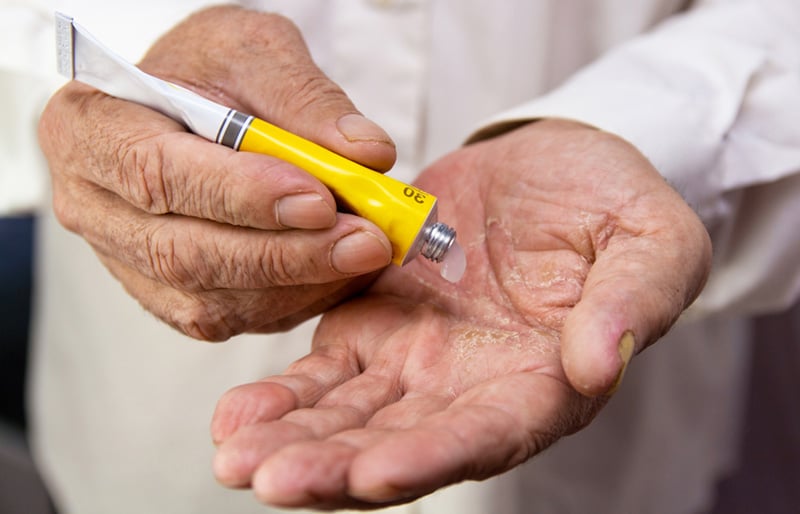Topicals & Non-Pharmacologic Options

According to the Centers for Disease Control (CDC), an average of 35.1% of people experience work-related health problems, the most common injuries resulting in pain. The field of pain management is a broad condition with several complexities requiring attention. The intricacies of treating a patient’s pain depend on various factors such as the type of pain, whether the pain is acute or chronic, and if the pain levels may be sufficiently managed with one treatment method. Practitioners must also consider if the condition requires a combination non-pharmacologic and pharmacological treatments to help relieve or alleviate the pain. The goal of pain management is to provide a safe and effective variety of treatment options to injured workers to ensure timely recovery.
While often overlooked, topical analgesics are a valuable option to consider in pain management for injured workers. The most prescribed method to treat acute and chronic pain is through oral analgesics, which can often cause adverse system effects, including potentially severe gastrointestinal disorders. Topical analgesics, however, provide the advantage of minimal adverse systemic effects while providing the same analgesic relief, which at times can be more effective than an oral analgesic. In a survey conducted by Chinese and Australian researchers, medical providers cited fewer systemic adverse events, the lack of drug-drug interactions with other oral medications, and ease of use to justify their preference for topicals. (4)
In addition, topical analgesics have the benefit of being applied directly over the painful site with desirable clinical efficacy. Research from the Mayo Clinic of Arizona demonstrates that topical analgesics reduced first bypass metabolism, diminished drug-to-drug interactions, and improved patient compliance. For many chronic opioid patients, the results revealed an improvement in their pain when using topical treatments and a subsequent reduction in opioid use. For example, in a randomized and double-blind trial that involved acute soft tissue injuries, patients were treated with either ketoprofen gel 2.5% twice daily or a placebo for seven days. The results showed a significant reduction in pain scores from baseline on day three and day seven of the treatment with the ketoprofen gel, with a P value of 0.001. (5) Overall, topical analgesics offer a productive alternative when a patient cannot ingest oral medication, would prefer not to take oral medications that may interfere with another treatment, or are concerned about systemic side effects and the risks of addiction. In terms of availability, topicals are accessible commercially and can also be compounded at the request of a provider to meet a patient’s specific needs. Due to these numerous advantages, physicians are increasingly prescribing topical products to injured workers.
Another pain management approach is the utilization of non-pharmacologic and pharmacological treatments. A nonpharmacologic pain management treatment is a way to reduce pain without administering any medications, while a pharmacologic method involves employing a prescription or over-the-counter medication options. Working with pharmacologic and non-pharmacologic therapies can eliminate the need for an advanced pain treatment medication, allow for a reduction in oral medication dosages, reduce the risk of experiencing adverse effects, and lessen the potential risk of abuse, all while providing long-term pain relief solutions. Some of the most prescribed non-pharmacologic treatments include heat or ice therapy to decrease pain and swelling, physical therapy, massage, acupuncture, and the use of a transcutaneous electrical nerve stimulation unit (TENS).
Several studies demonstrated the benefits of non-pharmacologic therapies. A randomized double-blinded trial conducted by the University of Vienna with acute posttraumatic hip pain patients produced results signifying high reductions in pain and anxiety with the use of TENS which provided effective and fast-acting pain relief when compared to the placebo. (1)(2) Similarly, Australian-based researchers found that the addition of acupuncture to pharmacological treatment saw reduced pain and enhanced function when compared to pharmacological therapy alone.1 International Anesthesia Research Society findings concluded that patients who experienced minor trauma and small injuries who received acupuncture treatment displayed improved pain relief, diminished anxiety, and noted upticks in overall satisfaction scores. (1)(3)
While managing pain is a tumultuous process with evaluation dependent on individual needs, various treatments are becoming more widely available with new technologies on the horizon. These remedies can effectively be used alone or in combination with pharmacologic options to best manage an injured worker’s pain. In all, a collaborative decision-making process between the patient and their medical providers is critical to positive and sustainable recovery outcomes.
Citations:
Pak SC, Micalos PS, Maria SJ, Lord B. Nonpharmacological interventions for pain management in paramedicine and the emergency setting: a review of the literature. Evid Based Complement Alternat Med. 2015;2015:873039. doi:10.1155/2015/873039
Lang T., Barker R., Steinlechner B., et al. TENS relieves acute posttraumatic hip pain during emergency transport. The Journal of Trauma—Injury, Infection and Critical Care. 2007;62(1):184–188. doi: 10.1097/01.ta.0000197176.75598.fc.
Kober A., Scheck T., Greher M., et al. Prehospital analgesia with acupressure in victims of minor trauma: a prospective, randomized, double-blinded trial. Anesthesia and Analgesia. 2002;95(3):723–727.
Mei F, Li J, Zhang L, et al. Preference of Orthopedic Practitioners Toward the Use of Topical Medicine for Musculoskeletal Pain Management in China: A National Survey. Orthop Surg. 2022;14(10):2470-2479. doi:10.1111/os.13446
Maloney J, Pew S, Wie C, Gupta R, Freeman J, Strand N. Comprehensive Review of Topical Analgesics for Chronic Pain. Curr Pain Headache Rep. 2021;25(2):7. Published 2021 Feb 3. doi:10.1007/s11916-020-00923-2
Other Posts You Might Be Interested In
Subscribe to email updates
Stay up-to-date on what's happening at this blog and get additional content about the benefits of subscribing.


